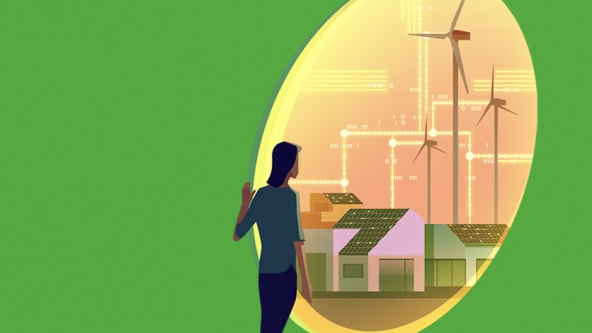In November’s Industrial Strategy white paper: Building a Britain fit for the Future, the Government identifies infrastructure as one of the UK’s “foundations of productivity”. Nowhere is this truer than energy. It powers everything from data centres to supermarket freezers. Without energy, production would run to a standstill and the UK economy would fail.
But much of the infrastructure we rely on to generate and distribute energy is old, inefficient and unfit for the demands of the 21st century. Our nation’s energy needs are met and managed by systems that predate the internet, and for the UK economy to thrive, we need infrastructure that promotes, leverages, and incentivises smart sustainable energy.
A turning tide
The way we generate energy is changing. Governments around the world are waking up to the environmental risks posed by global warming, and as renewable technology falls in price, fossil fuels are becoming irrelevant. The increasingly expensive means of extracting and securing supply across borders have persuaded many to exploit renewable sources on their own turf.
Indeed, the UK has made great strides towards decarbonising our energy supply. Within ten years, coal-powered generation will be completely eradicated and, along with Spain, the UK holds second place for wind generation in all of Europe (Germany holds the top spot). According to the Government’s White Paper, the Clean Growth Strategy has cut greenhouse gas emissions by 42% since 1990, while simultaneously growing the economy by two-thirds.
But despite these huge advances, we’ve yet to realise the potential of a fully-integrated smart energy management system. Instead, we’ve been running next-generation technology on ageing energy infrastructure creaking under the strain of changing demand, generation, and consumer habits.
Is the UK’s energy infrastructure fit for purpose?
When our national electricity grid began trials in the early 20th century, few could have predicted how much we would depend on energy today. As well as coping with our insatiable appetite for power, the grid must now adapt to the specific challenges of renewable generation, with lots of smaller distributed power stations generating according to the weather, as opposed to the more consistent generation from fossil fuels and nuclear. This creates much more variability in the amount of generation and uncertainty on timing, making it more difficult to ensure that demand for electricity is always in balance with supply.
One aspect to consider is the amount of stability in the National Grid (system inertia). The National Grid measures this by estimating its state at any given moment. While these calculations are based on system patterns, they’re no substitute for real-time data, especially as renewables are, by their very nature, variable generators. Without knowing exactly what’s being generated and where, network costs increase to compensate for resulting inefficiency, and these often trickle down to customer’s energy bills.
Decarbonising transport presents even greater demands on the grid. As we move towards electric vehicles, the grid must cope with massive draws on power as people charge their vehicles (most likely overnight). The Committee on Climate Change has recommended that 60% of all new car and van sales be electric by 2030, but without an efficient, smart energy system to balance supply and demand (and a network of charge points to top up batteries on-the-road), we’re wide open to failure.
Groundwork for success
The good news is that the Government is aware of these problems. It has already announced a plan to invest around £600 billion in new infrastructure, including a revitalised energy network by 2022 (as set out in its Smart Systems and Flexibility Plan), a £100 million pot to “incentivise the purchase of battery electric vehicles”, and a new £400 million Charging Infrastructure Investment Fund to build charge points throughout the country.
This is welcome, but it must also come with a regulatory framework that encourages innovation and fair competition. The Octopus Energy Investment team backs many of the important technologies underpinning intelligent energy management, and removing barriers to market is essential to realise the benefits.
One such example is Reactive Technologies, a cloud-based communications solution that delivers real-time grid data, right down to the postcode, at a fraction of today’s speeds. Its GridMetrix technology is already helping network operators stabilise the grid, reducing the risk of blackouts, brownouts, and power surges.
Sharing responsibility
With efficient energy infrastructure, granular data, and intelligent management, many of the current system’s problems become lucrative opportunities. Take demand-side response, for example, which shifts some of the responsibility of grid balancing to the consumer. If you’re a Tesco supermarket manager, the grid might pay you to turn off freezers for a minute or two at times of peak demand, without damaging stock, but helping keep the grid’s equilibrium.
Octopus Energy, our renewable energy supply business, is doing the same with the Agile Octopus time-of-use tariff. This is the first UK tariff to follow the wholesale price of energy on a half-hourly basis, and when the grid is overloaded, it can pay you to use energy. It gives customers choice, empowering them to use less and at cheaper times.
Another solution is vehicle-to-grid. Electric vehicle (EV) fleets have massive storage potential and could be used to store energy during peak generation and low demand, while releasing energy when demand is high and generation low (and paying you for the privilege). Octopus Electric Vehicles is trialling a vehicle-to-grid scheme right now, funded by Innovate UK and in partnership with ChargePoint Services and the Energy Savings Trust.
You could even sell stored energy to the neighbours in your community, or provide a charge-point service for other drivers as part of the sharing economy (think Airbnb for electric vehicle owners).
The proposals laid out in the Industrial Strategy white paper are a promising starting point in the drive to change the way we buy, use, and manage energy. But for it to be truly successful, we need flexible, data-driven infrastructure to support progress. Without it, we risk losing the benefits of innovation and investment through the widening cracks of an overburdened and outdated energy system.


